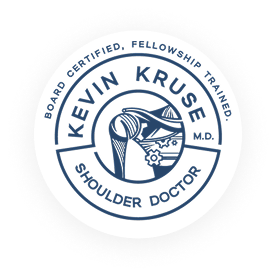What is Computer Navigation for Shoulder Replacement?
Computer navigated shoulder replacement is an image-guided, minimally invasive surgical procedure in which the damaged or worn out articulating surfaces of the shoulder joint are removed and replaced with artificial prostheses under the assistance of advanced computer technology to relieve pain and restore normal functioning of the shoulder joint. The computer navigation system provides information and guidance that aids your surgeon to secure precise alignment and accurate positioning of the implants to accomplish improved accuracy and results.
The computer navigation system involves the following components:
- A special navigation camera that visualizes your shoulder joint and creates images
- Smart instruments that can be tracked by the camera
- Computer with specialized surgical navigation software to integrate the images with surgical information
Anatomy of the Shoulder
The shoulder joint (glenohumeral joint) is a ball and socket joint, where the head of the humerus (upper arm bone) articulates with the socket of the scapula (shoulder blade), which is called the glenoid. The two articulating surfaces of the bones are covered with cartilage, which prevents friction between the moving bones. The cartilage is lubricated by synovial fluid. Tendons and ligaments around the shoulder joint provide strength and stability to the joint.
Indications for Computer Navigation for Shoulder Replacement
Some of the indications for a computer-navigated shoulder replacement include:
- Treatment of arthritic conditions, such as osteoarthritis and rheumatoid arthritis of the shoulder joints
- Severe shoulder joint pain that limits your daily activities (such as dressing, getting up from a chair, or climbing stairs)
- Dislocation of the shoulder joint
- Severe shoulder joint fracture or trauma
- Failed total shoulder replacement surgery
- Failure to obtain pain relief from medications, injections, physiotherapy or other conservative treatments
Preoperative Preparation for Computer Navigated Shoulder Replacement
Preoperative preparation for computer navigation for shoulder replacement will involve the following steps:
- A thorough examination by your doctor is performed to check for any medical issues that need to be addressed prior to surgery.
- Depending on your medical history, social history, and age, you may need to undergo tests such as blood work and imaging to help detect any abnormalities that could threaten the safety of the procedure.
- You will be asked if you have allergies to medications, anesthesia, or latex.
- You should inform your doctor of any medications, vitamins, or supplements that you are taking.
- You should refrain from medications or supplements such as blood thinners, aspirin, or anti-inflammatory medicines for 1 to 2 weeks prior to surgery.
- You should refrain from alcohol or tobacco at least 24 hours prior to surgery.
- You should not consume any solids or liquids at least 8 hours prior to surgery.
- Arrange for someone to drive you home as you will not be able to drive yourself after surgery.
- A written consent will be obtained from you after the surgical procedure has been explained in detail.
Procedure for Computer Navigation for Shoulder Replacement
Computer navigation provides your surgeon with real-time 3-D images of your mapped shoulder joint and the surgical instruments during surgery. The data for the images is provided by infrared sensors fixed to the bones of the shoulder and surgical instruments. Their position is tracked by an infrared camera placed above the surgical table, which is connected to a computer. The computer then generates real-time images with the help of the appropriate software to guide your surgeon to precisely resurface and cut the bones of the shoulder, and fix the implant precisely and accurately according to the preoperative surgical plan.
The surgery is performed entirely by your surgeon. Computer navigation is just a tool to guide your surgeon and ensure accuracy. It cannot replace the skills of an experienced surgeon.
Postoperative Care and Recovery
In general, postoperative care instructions and recovery after computer navigation for shoulder replacement will involve the following steps:
- You will be transferred to the recovery area to be monitored until you are awake from the anesthesia.
- Your nurse will monitor your blood oxygen level and other vital signs as you recover.
- You may notice some pain, swelling, and discomfort in the shoulder area. Pain and anti-inflammatory medications are provided as needed.
- Medications will also be prescribed as needed for symptoms associated with anesthesia, such as vomiting and nausea.
- Antibiotics are prescribed to address the risk of surgery-related infection.
- It is important to keep the surgical site clean and dry. Instructions on surgical site care and bathing will be provided.
- Your arm may be secured with assistive devices such as a sling or a cast for the first few weeks.
- Refrain from smoking as it can negatively affect the healing process.
- Eating a healthy diet rich in vitamin D is strongly advised to promote healing and a faster recovery.
- Refrain from strenuous activities and lifting heavy weights for the first couple of months. A gradual increase in activities over a period of time is recommended.
- An individualized physiotherapy protocol will be designed to help strengthen your shoulder muscles and optimize shoulder function.
- You will be able to resume your normal activities in a couple of months; however, return to sports may take 4 to 6 months or longer.
- A periodic follow-up appointment will be scheduled to monitor your progress.
Advantages of Computer-Navigated Shoulder Replacement
Some of the advantages of computer-navigated shoulder replacement include:
- A short stay in the hospital
- Minimal scarring
- Less blood loss
- Small incisions
- Longevity of implant
- Precise positioning of implants
- Improved alignment
- Minimal tissue loss
- Minimal chance of implant displacement
Risks and Complications of Computer-Navigated Shoulder Replacement
Computer-navigated shoulder replacement is a relatively safe procedure; however, as with any type of joint replacement procedure, there may be some risks, such as:
- Infection
- Blood clots
- Injury to nerves and blood vessels
- Bleeding
- Anesthetic/allergic reactions
BLUEPRINT MIXED REALITY TECHNOLOGY
The first shoulder arthroplasty procedure using Blueprint Mixed Reality Technology was performed at Mayo Clinic’s campus in Rochester, Minnesota. Joaquin Sanchez-Sotelo, M.D., Ph.D, performed the procedure utilizing the software, which provides a 3-D holographic view of a patient’s pre-operative plan.

